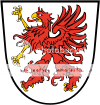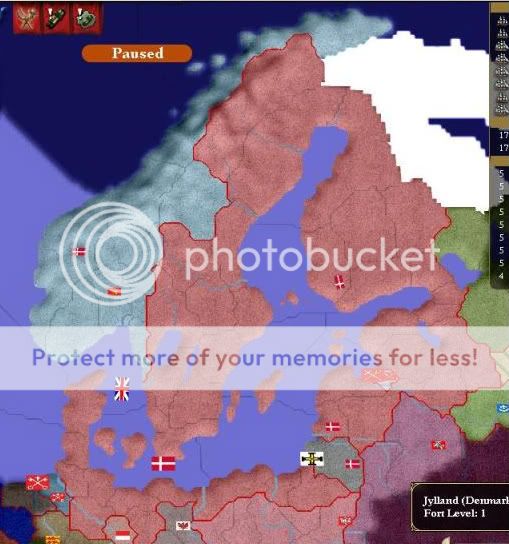Chapter XV: The Second Baltic War

The coat of arms of the house of Pomerania

The coat of arms of the house of Pomerania
As we saw, by 1523 the Union was a well consolidated dual monarchy. The dukes of Meissen and Bremen were vassals of the Danish-Swedish crown, and the colonization of Vinland was well under way. Meanwhile the free trade policies of the crown ensured that many young people rose to great wealth and fame by trading in far away countries. The treath of the Empire was considerably lessened by the election of Juan of Spain as Holy Roman Emperor. Although the Spanish navy was strong, it was not nearly as great a challenge as the armies of France. The only German power able to effectively challenge the Union was the kingdom of Brandenburg, which had expanded at the expense of its lesser neighbours.
On the other side of the North Sea, however, a new Empire was looming. Great Britain had grown into the main foe of the Union, and was not content with the conquest of Orkney. The colony of Vinland bordered British possesions in the new world, and the emperor was eager to expand. With the largest navy in Christendom, this was a major concern for king Frederik. In 1523 he was an elderly man of 48, and mostly intent on developing his kingdom into a more modern state with centralized power and a modern army. The prospect of building a fleet powerful enough to resist the British was generaly concidered too expensive, so more emphasis was put in being able to stop an invasion.
In October of 1523, the British Empire declared war. Along with the British came their German allies of Brandenburg and several German and Italian city states. The Union was backed by Poland, Muscowy and its two German vassals Meissen and Bremen. Seeing Lithuania as a minor treath, the main armies of the Baltic were sent south to break the neck of the king of Brandenburg while the Finnish guard was sent to Stockholm to deal with an uprising instigated by British agents. The campaign in Brandenburg was huge success. Polish armies moved in from the East and won the first major victory for Poland in more than half a century when they occupied all provinces east of the capital in Berlin before laying siege to the city. Meanwhile Danish and Norwegian troops occupied Hinterpommern, and the enclave of Lüneburg was seized by the duke of Bremen.
While the Danish armies were busy occupying the Northern German provinces, the Teutonic Order decided to seize the opportunity to expand into Danzig, which they had lost more than a hundred years before in the first Baltic war. Since then, the Order had been incorporated for 50 years as a religious movement within the Polish state, but had been given sovereign power over the Baltic coast by the treaty of Krakow during the first war of the Tripple Alliance. How the Hochmeister could ever think, that he was strong enough to take on the Union remains a mystery. The order consisted of three provinces and an army of 7000, with no allies. The Union had an alliance of three major Baltic powers, a standing army of 40000, 25000 of which had just finished the total annihilation of a mediumsized regional power neighbouring the Order, and a fleet that was capable of blockading all the orders ports within weeks. The outcome was almost granted. On the 26th of December, 1524, the kingdom of Brandenburg was reduced to two provinces, the rest was split between Denmark and Poland. The Danish armies moved into the Baltic Region and soon occupied all major strongholds of the Order except for Marienburg.
But while the German powers once again fell to the forces of the Union, the new foe was not so easily toppled. The British navy entered the Baltic in an unusualy warm February and landed armies in Skåne and on Gotland. The army in Skåne was quickly defeated, but the large naval precence in the Baltic prevented a rescue of Gotland. Meanwhile, the colonial army in Vinland was annihilated by a British army moving in from Innu, and the city of Frederikstad was captured by the British. On the 16th of March, 1525, a peace was signed in which Bremen and Meissen were freed from their bonds of vassalage. Immediately thereafter, Bremen left its alliance with the Union, while Meissen stayed protected against its larger neighbour Bohemia. The reason for this humiliating peace at a time when the war was still more or less equal is to be found in the fact, that a prolonged war would most likely have led to a total defeat. The British delegation originialy proposed a peace in which Gotland and Finland was to be released as sovereign states, and Frederikstad was to be given up to the British. Though this was a prepostrous claim, the writing on the wall was clear. These demands could well be forced through if the war continued. In the end, the British were content with humiliating Frederik, who on his side was more than happy to keep the lands of the crown intact, and not let the Scandinavian settlers in Vinland suffer under the British yoke.
And on the same day as the peace was signed, Marienburg fell and the Order was forced to give up all other possessions than the immediate surroundings of the city and acknowledge the king of the Union as ther sovereign lord. So though some vassals had been lost, much more had been gained durring the war.
All of the Baltic coast except for Marienburg was conquered as lands of the Danish crown, and Brandenburg had been crippled while Poland had been strengthened. The new German provinces were rich and helped finance the effort to create a proper navy. After the bitter experience of the last war, king Frederik was resolved never to be caught off guard by a British fleet again. The age of the Scandinavian navy was starting.

The union after the second baltic war
Last edited:





